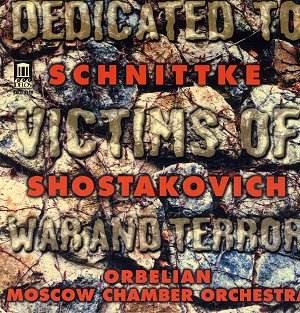I enjoyed Orbelian’s disc of Rachmaninov’ Aleko,
also on Delos, when
I reviewed it last year (DE3269). Staying with Russian repertoire,
here is a coupling that works well, as long as one ignores the playing
time. Just over three-quarters of an hour is unacceptable these days,
surely, especially at full price.
Shostakovich’s Chamber Symphony, Op. 110a is, in fact,
a transcription of his Eighth String Quartet by the conductor Rudolf
Barshai (who did the same to the Third and Tenth also, although this
is by far the most popular of the arrangements). The Eighth Quartet,
full of self-quotations (most prominently, perhaps, from the First Cello
Concerto, but the First Piano Concerto, the Second Piano Trio and Lady
Macbeth all turn up, too. Very recently I have expressed my doubts
as to the BBC Legends issue of a live
performance by the Borodin String Quartet (BBCL4063-2).
Orbelian’s account brings problems with it, too. There
is an inevitable cushioning effect to Shostakovich’s bare and sometimes
savage textures by transferring it to a massed group. The Moscow Chamber
Orchestra exacerbates this by, in general, underplaying accents (not
spiky enough) or sometimes by crucial lapses in ensemble. Long-breathed
first violin melodies lose their sense of desolation when played en
masse. The most successful movement is the fourth (the second of
a total of three Largos in the work). The use of contrast is effective,
and Orbelian manages to keep the drama and emotion over the silences,
but it is not enough to rescue an over-inflated and sometimes scrappy
performance.
The performance of the Concerto for Piano and Strings
by Alfred Schnittke (1979) is more successful. The two pieces on the
disc work well as a coupling, and seated at the piano seems to bring
out the best in both Orbelian and his orchestra. Orbelian’s sensitive
playing suits the sometimes Chopinesque writing of the first movement
well. The piece is formally interesting: a set of variations on a theme
that only appears at the very end, combined with elements of Sonata
Form. The ‘Tempo di valse’ third movement works particularly well: it
is a black, relentless waltz with a cumulative energy all of its own.
The performance projects this dark energy well; the glassy stillness
of the close of the work is also effective.
There is not enough here, musically, to deserve a recommendation,
however. The recording is acceptable, if too close for comfort.
Colin Clarke


